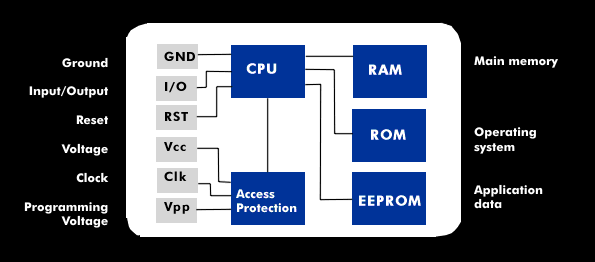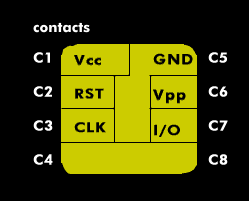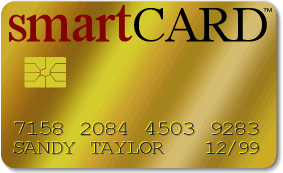smartcard
Smartcards, also known as Integrated Circuit Cards( ICC) or microprocessor cards, are contact plastic cards with their own processor, measuring 85.6 x 53.58 x 0.76 mm, the standardized size of ID1 cards. Smartcards used to have a magnetic stripe, which has been replaced by a chip.
Structure of smart cards
Smartcards have their own processor with Random Access Memory( RAM), Read Only Memory( ROM) and Electrically Erasable PROM( EEPROM), which is supplied with a clock signal from outside. The ROM houses the smart card operating system such as CardOS, TCOS, MultiFunctionCard( MFC) or others. The EEPROM is the erasable read-only memory where the application data and encryption algorithms are stored. The data stored in the smart card memory can be read by appropriate readers and transmitted to other communication devices. The smartcard communication is mostly done via Universal Asynchronous Receiver/Transmitter( UART), which is however replaced by the USB interface. The ATR protocol (Answer to Reset) is used as the transmission protocol.
A smartcard provides its own services, from data storage to encryption. The specifications of the smart card are defined in the ISO 7816 standard. Smartcard communication with the smartcard reader takes place via gold-coated contact fields. There are corresponding transmission protocols for data transmission between the smart card and the terminal, such as the byte-oriented half-duplexT=0 protocol and the block-oriented T=1 protocol.
The gold-plated contact fields of the smart card
Smartcards have eight contact fields, designated C1 to C8. The supply voltage, ground, clock signal and reset are routed via these contact fields. Furthermore, there is a contact field for the data transmission and the programming voltage. This prevents attacks where the write process is manipulated by changing the programming voltage. Two contact fields are free for future applications.
The supply voltage is supplied via the contact field C1 (Vcc). It is divided into classes. In the past, the supply voltage was 5 V, which corresponded to Class A; it was lowered to 3 V for Class B and to 1.8 V for Class C. This was the first time that Class A was used. A further reduction to 1.2 V is in preparation. The maximum current is 10 mA. The reset signal, which resets the microprocessor, is supplied via contact field C2. The clock is supplied via contact field C3. The clock must be supplied from outside, since the microprocessors of the smartcards do not generate their own clock. The clock frequencies are 3.57 MHz and 4.91 MHz. Smartcards with their own clock generation operate with clock frequencies of up to 15 MHz.
Contact fields C4 and C8 are reserved for future use (RFU). C5 is the ground contact, which must be applied before the supply voltage according to the ISO 7816-3 standard. The programming voltage used to be supplied to contact area C6. To prevent tampering, the programming voltage is obtained from the supply voltage by voltage multiplication. The contact is therefore no longer used. As far as data transmission is concerned, this takes place via contact area C7. Asynchronous transmission takes place in half- duplex with a data rate of 9,600 baud or with a fixed divider ratio of the system clock.
Areas of application for smart cards
Smartcards are used primarily in the areas of e-business, e-commerce and e-pament. They can also perform authentication and authorization functions, providing access to vending machines, computers and communications equipment, for example, as an identification card on the Internet. They can be used as RSA cards for creating digital signatures or as SIM cards for GSM cell phones. The term smart card is a registered trademark of the Canadian company Groupmark.



